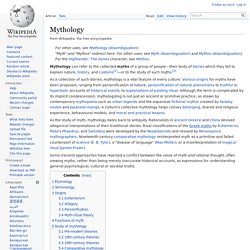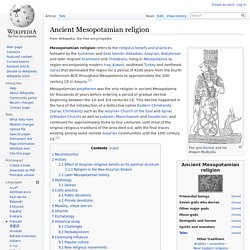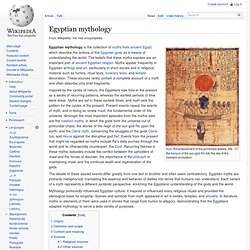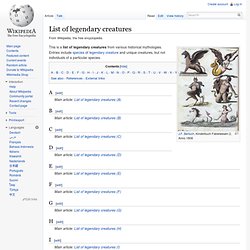

Mythology. Mythology. Some (recent) approaches have rejected a conflict between the value of myth and rational thought, often viewing myths, rather than being merely inaccurate historical accounts, as expressions for understanding general psychological, cultural or societal truths.

Etymology[edit] The English term mythology predates the word myth by centuries.[5] It appeared in the 15th century,[7] borrowed whole from Middle French mythologie. The word mythology "exposition of myths" comes from Middle French mythologie, from Late Latin mythologia, from Greek μυθολογία mythologia "legendary lore, a telling of mythic legends; a legend, story, tale," from μῦθος mythos "myth" and -λογία -logia "study. "[8][9] Both terms translated the subject of Fulgentius's 5th-century Mythologiæ, which was concerned with the explication of Greek and Roman stories about their gods.
Chinese mythology. Chinese mythology refers to those myths found in the historical geographic area of China: these include myths in Chinese and other languages, as transmitted by Han Chinese as well as other ethnic groups (of which fifty-six are officially recognized by the current administration of China).[1] Chinese mythology includes creation myths and legends, such as myths concerning the founding of Chinese culture and the Chinese state.

As in many cultures' mythologies, Chinese mythology has in the past been believed to be, at least in part, a factual recording of history. Thus, in the study of historical Chinese culture, many of the stories that have been told regarding characters and events which have been written or told of the distant past have a double tradition: one which presents a more historicized and one which presents a more mythological version.[2] Historians have written evidence of Chinese mythological symbolism from the 12th century BC in the Oracle bone script.
Mesopotamian religion. The god Marduk and his dragon Mušḫuššu Mesopotamian religion refers to the religious beliefs and practices followed by the Sumerian and East Semitic Akkadian, Assyrian, Babylonian and later migrant Arameans and Chaldeans, living in Mesopotamia (a region encompassing modern Iraq, Kuwait, southeast Turkey and northeast Syria) that dominated the region for a period of 4200 years from the fourth millennium BCE throughout Mesopotamia to approximately the 10th century CE in Assyria.[1] Mesopotamian polytheism was the only religion in ancient Mesopotamia for thousands of years before entering a period of gradual decline beginning between the 1st and 3rd centuries CE.

Reconstruction[edit] As with most dead religions, many aspects of the common practices and intricacies of the doctrine have been lost and forgotten over time. Ancient Egyptian religion. Egyptian mythology is the collection of myths from ancient Egypt, which describe the actions of the Egyptian gods as a means of understanding the world.

The beliefs that these myths express are an important part of ancient Egyptian religion. Myths appear frequently in Egyptian writings and art, particularly in short stories and in religious material such as hymns, ritual texts, funerary texts, and temple decoration. These sources rarely contain a complete account of a myth and often describe only brief fragments. The details of these sacred events differ greatly from one text to another and often seem contradictory. Egyptian myths are primarily metaphorical, translating the essence and behavior of deities into terms that humans can understand. Mythology profoundly influenced Egyptian culture. Origins[edit] The development of Egyptian myth is difficult to trace. Another possible source for mythology is ritual.
Celtic mythology. Overview[edit] Though the Celtic world at its apex covered much of western and central Europe, it was not politically unified nor was there any substantial central source of cultural influence or homogeneity; as a result, there was a great deal of variation in local practices of Celtic religion (although certain motifs, for example the god Lugh, appear to have diffused throughout the Celtic world).

Créatures mythologiques. Lists of fictional species. List of fictional humanoid species. List of legendary creatures. This is a list of legendary creatures from various historical mythologies.

List of fictional extraterrestrials. This list of fictional extraterrestrial species is subsidiary to the lists of fictional species and is a collection of various notable extraterrestrial species that appear in various works of fiction.

It is limited to well-referenced examples from literature, film, television, comics, animation and video games. This list excludes cases in which only a single member of a species is shown, such as E.T. the Extraterrestrial. Literature[edit] This section deals with notable species from published works, including short-stories, novels, novellas and poems. See: Comics[edit] This section deals with species that are depicted in comic books or strips, manga or similar works.
Film[edit] This section deals with feature length films or made-for-television movies. Television[edit] This section deals with television shows. Television animation[edit] This section deals with animated television shows, such as non-realistic CGI, traditional animation, and stop-motion animation. Mythical Creatures. Jewish mysticism. Mystic Traditions.